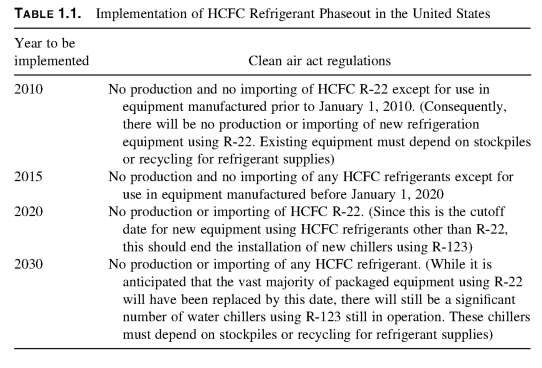Refrigerants
Any substance which absorbs heat, can be called a refrigerant. Secondary refrigerants, such as water or in brine, absorb heat, but do not pass the phase-change process. The main refrigerants, then, those substances which possess chemical, physical and thermodynamic properties, which allow to use them effectively in the typical for the vapour compression cycle.
In the vapor compression cycle, the refrigerant must satisfy several (and sometimes conflicting requirements:
- The refrigerant must be chemically stable in liquid and vaporous state.
- Refrigerants for HVAC applications must be non-combustible, and are of low toxicity.
- Finally, the thermodynamic properties of the refrigerant must correspond to the temperature and pressure ranges necessary for the application of
. At the beginning of refrigerants, developed in the 1920s and 1930s, is used in HVAC applications were mainly chemical compounds composed of chlorofluorocarbons (CFCs), such as R-11, R-12 and R-503. While a stable and efficient in the range of temperatures and pressures required for HVAC, any escaped REFRIGERANT gas turned out to be long-lived in the atmosphere.
In the lower atmosphere, CFC molecules absorb infrared radiation and thus contribute to the warming of the atmosphere. Once in the upper atmosphere, the CFC molecule breaks into production of chlorine that destroy ozone and, therefore, damage to the ozone layer of the atmosphere that protects the earth from excessive ultraviolet radiation.
Production of CFC refrigerants in the United States and most other industrialized Nations, was liquidated in accordance with the international agreement of 1996. While there is still refrigeration equipment using CFC refrigerants, no new hardware, using these refrigerants is now available in the United States.
The researchers found that, altering the chemical composition of CFCs, substituting hydrogen atom of one or more atoms of chlorine or fluorine, led to a significant reduction in the life of molecules and, consequently, reduction of negative impacts on the environment can have. These new compounds called hydrochlorofluorocarbons (HCFCs)are currently used in refrigeration and air conditioning, systems of R-22 and R-123.
While HCFCs reduced the potential environmental damage of refrigerants into the atmosphere, the potential for damage has not been completely eradicated. Again, in accordance with international agreement, this class of refrigerants planned replacement for installation of new equipment for 2010-2020, with a full stop of manufacture and import, provided by 2030 as presented in Table 1.1.
The third class of refrigerants, called hydrofluorocarbons (HFCs), is not regulated by international Treaty, and is considered to be, at least temporarily, the most harmless compounds and is now widely used in HVAC refrigeration systems.
Cooling and conditioning, the equipment is currently undergoing a transition in the use of refrigerants. R-22 has been the workhorse for piston compressor HVAC systems. Leading replacement of R-22 in new equipment, R-410A and, to a lesser extent, R-407C, both of which are blends of HFC compounds.
R-134A, HFC refrigerant used in positive pressure compressor system. At least one manufacturer continues to have a negative pressure centrifugal compressor water chillers with R-123 (HCFCs), but it is expected that by 2010 production of new negative pressure chillers using HCFC will be terminated. These same manufacturers are already market positive-pressure centrifugal compressors with R-134A (although one manufacturer currently limits sales outside the United States, as in many countries, especially in Europe, accelerated the replacement of HCFC).

On the basis of the average of 20-25 years of life water cooler (see Chap. 8) and HCFC refrigerant replacement graphics are shown in Table 1.1, the owners should avoid purchasing any new chillers R-22. After 2005, the owners should avoid buying a new chillers with R-123.
ASHRAE Standard 34-1989 classifies refrigerants according to their toxicity (A = nontoxic and B = evidence of toxicity defined), and Flammability (1 = no flame progation, 2 = low Flammability, and 3 = high Flammability). Thus, all refrigerants fall under one of the six safety groups, A1, A2, A3, B1, B2, B3, or. For refrigeration and air conditioning, systems, only A1 refrigerants should be considered. Given in the table 1.2 security group classification of refrigerants widely used in HVAC applications...
|

